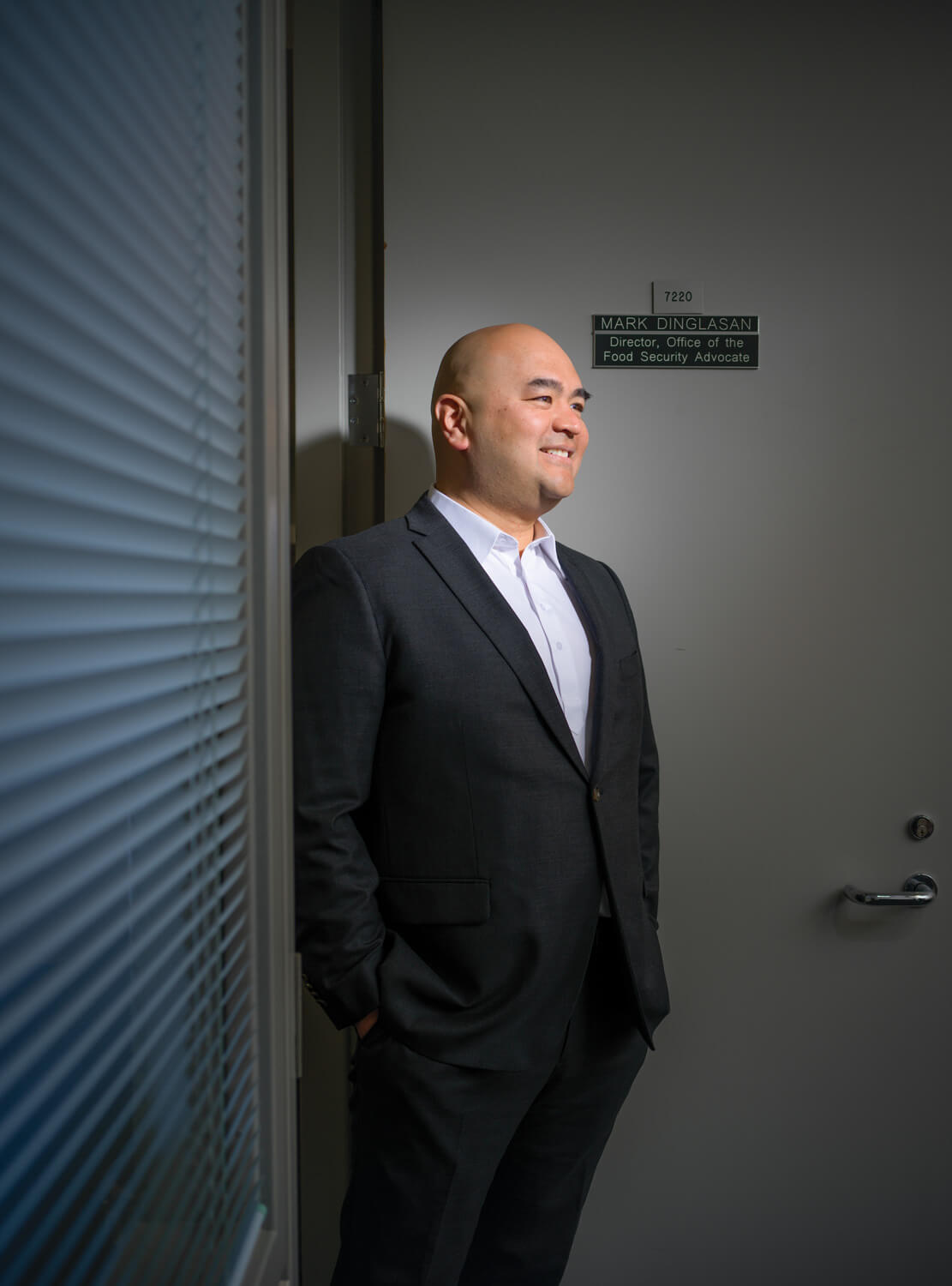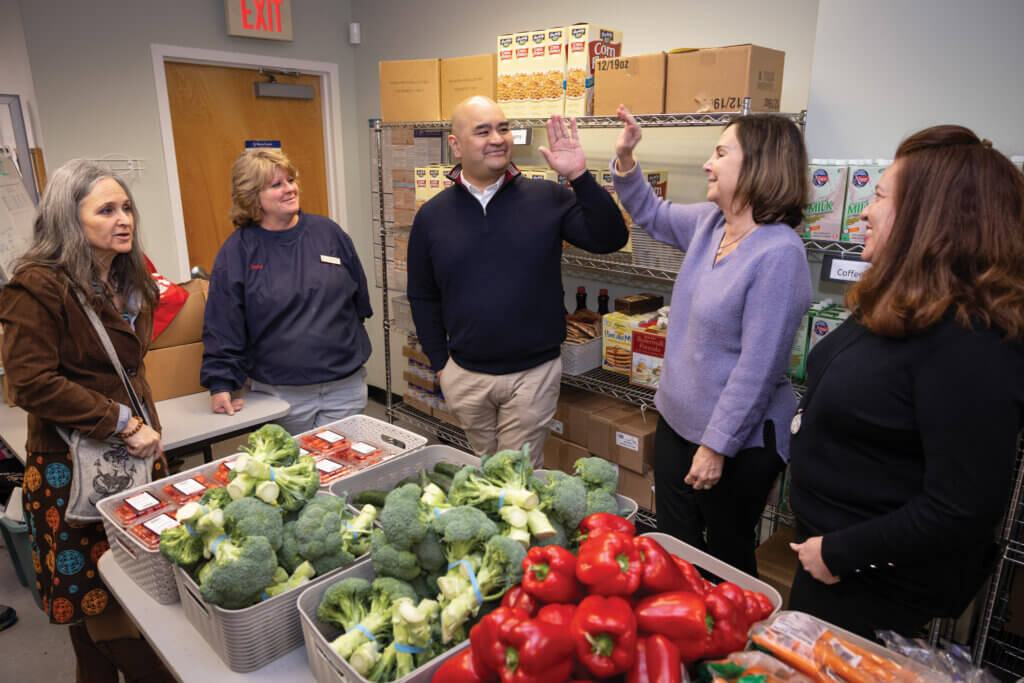
Food for Thought
Mark Dinglasan, the nation’s first state-level food security advocate, explains why efforts to end hunger need to go beyond simply handing out food.
In September, Mark Dinglasan ’03 was appointed director of the Office of the Food Security Advocate by New Jersey Gov. Phil Murphy—the first role of its kind in the state and in the nation. His charge from the governor was broad but clear: Move the needle on food insecurity.
Dinglasan spoke to us about what he plans to do in this position, which will go well beyond funding food banks; the complicated links between childhood trauma, community, and food insecurity; and how he hopes his office can be a role model for the rest of the country.
We noticed your office has some fun décor, including images of Voltron. We know you’re passionate about your work, but clearly, you have other passions. Before we get too deep into food insecurity, we have to ask about these pictures.
I’m a fan of antiquing, and I came across this limited-edition artwork from an artist who focuses on retro foil-type work. These Voltron images have been a great talking point with colleagues. This position is so new that it was a bit of a mystery to everyone around me. I think people were intimidated by me and (what) the role of this office was, so I thought, “If I bring a little bit of my personality to work, hopefully it’ll bring down the walls a little bit.” So I brought half my collection, which thrilled my wife. As a result, I found the person in the Department of Agriculture who loves to collect history memorabilia. I also found the Star Wars folk.
There’s always a Star Wars person in the office. Always.
I am the Star Wars person.
Yoda aside, talk to us a bit about your career trajectory launching from Monmouth.
Monmouth was a huge growing experience for me. I had done the study abroad thing. I had done the honors program. I thought I was going to be a lawyer, but when I went to New York Law School for a semester, I realized I wanted to be doing more. So I told my dean that I wanted to become a Catholic missionary, building homes and social justice programs in the slums, especially in the Philippines. She said, “If you don’t go, you will not succeed here. So go now and do that.”
I always thought I would go back to law school after my mission work, but I found my way to programming and event planning in the corporate sector of Chicago. I was three doors down from the corner office—thinking I had made it—when the economy crashed in ’08. That crash was an opportunity for me to reframe and find myself again. So I dove headfirst into nonprofit work in Chicago while earning my MBA.

What did that nonprofit work look like?
During that time, I worked for the first African American woman on the federal bench in Illinois, Judge Ann Williams. I was the fundraiser for her foundation, which supported youth programs that helped underserved kids get into college and law school and get clerkships. I learned everything about justice, equity, and diversity from Judge Williams and her colleagues. Later, I met another mentor, an attorney, who brought me into juvenile justice, advocating for kids who ended up in the system. It was that work that led me to where I am now.
I’m curious about the leap—or link—between juvenile justice and food insecurity.
Prior to me leaving Chicago in 2017, one in four homeless adults in the United States was a former youth in care, meaning they had spent time in the juvenile justice system. And a lot of kids we saw ended up in the system because of outcomes related to hunger, neglect, poor nutrition, and lack of safe, stable, humane housing. We used to say in juvenile justice that we’re at least two years behind the eight ball by the time a kid gets assigned to us.
I spoke to a lot of people who work in trauma and community building, especially in Chicago. My “aha moment” came when I realized I could combat issues we were seeing in juvenile justice by building food security.
What’s the difference between food emergency work and food security?
There’s a huge difference. Emergency work is just that—combatting hunger in emergency situations. Food security is different and largely about ongoing access. It was defined in 2001 by the United Nations, and they’re working on an expanded definition now, which I’ll use here: True food security exists when all people at all times have economic, physical, and social access to safe, sufficient, nutritious food for an active and healthy lifestyle. Their definition also includes dietary and cultural preferences.
This is clearly a national issue, but this is a state-focused job. What does food insecurity look like in New Jersey?
The challenges in New Jersey are not novel or new. Many of these problems are problems that have existed for quite some time in our state and in the country. The pandemic in 2020 just burned away the curtain that diverted our focus from this area. According to the Robert Wood Johnson Foundation, one in 12 people in New Jersey is food insecure—that means that one in 12 people have to decide between buying food or spending money on another need.
In addition, our costs are higher in New Jersey, so food simply costs more. And transportation is an issue here. Families need transportation to get the services they need. Those are just two of the issues that are specific to our state.
One in 12 people in New Jersey is food insecure—that means that one in 12 people have to decide between buying food or spending money on another need.
This role is the first for the state, but it’s also a first for the nation. What’s expected of you in the position in New Jersey? And what are you trying to establish for the country as you and your team build this out?
To be clear, there are a lot of other food security advocates from the other states. The difference with my office, and I think it’s part of the reason that makes New Jersey unique in this food security work, is that I’m the only state-level, executive-branch-level food security advocate.
What’s expected of me? I asked Governor Murphy, one on one, “What do you want me to do with this office?” And he looked at me and said, “Move the needle.” As a nation, we have tremendous opportunity right now. This White House administration created the first hunger conference in 60 years, so there’s this spotlight on food security work. As a nation, we are looking at this with greater intention. There’s a lot of great research going on right now—community-driven, participatory research and trauma-informed research. What that means is we’re not treating people as numbers, but we’re actually listening to communities. The pandemic supercharged us locally into where we were already headed with food security, and now we’re supercharging where we’re headed as a nation. If we’re going to move the needle on food security—if I’m going to do what my boss has asked me to do—we have to focus our collective impact on empowering communities. We have to look at three aspects of food security and empower our communities to reach them: economic, physical, and social access.
You approach your work from what’s called a holistic, trauma-informed lens. What does that mean to you?
A lot of my food security work is tied to adverse childhood experiences—trauma like physical or sexual abuse, violence in the home or community, stress. To combat this kind of trauma, you have to build community.
There are six major aspects of food security: access, availability, utilization, stability, agency, and sustainability. So the connection is if you care about preventing trauma, then you have to care about community building. If you care about community building, you have to figure out how to do it. And I think the way we do it is through food security and breaking down access barriers.
How do we go about accomplishing that? What does that mean in real terms?
I am organizing my work into three buckets. First, informing policy. We have a tremendous policy window here in New Jersey where our state assembly, our state senate, and our governor’s office are open to and creating these forward-thinking, nation-leading policies around food security. Now, somebody’s going to say, “Oh, you’re just saying that because you’re part of the administration.” The reality is, I’m a nonprofit guy who has worked on the front lines and never in a million years thought I would be the first nationwide state-level food security advocate. So for as long as I am in this role, I can advocate for and be in meetings where I say, “Hey, do you know that food security is tied to trauma and adversity? Do you know that if we want to end hunger we have to focus on economic mobility? And by the way, here’s research from New York, from Chicago, from Ohio that shows how it’s being done in other states.” I can share that knowledge and advocate for support from our partners in the legislature.
Second, philanthropy. Donations and gifts across the nation used to fund food programs, but the pandemic taught us that that’s not good enough. Where else should we be directing funds? I’ll be working with multiple foundations to build consensus around what we should be supporting.
Lastly, I’ll be working with local organizations—food banks, food pantries, housing organizations—so that we’re all saying the same thing and agreeing on the same definitions. What is the definition of food security? What is the definition of hunger? What does it mean to be food insecure?
We have to build common language and common understanding so that, collectively, we understand what helps and what hurts. And if we do that, then we can move the needle.